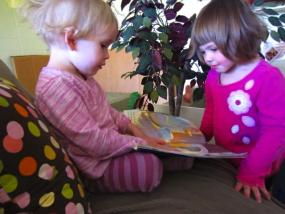When Toddlers Read to Friends

Imagine the number of times Kaia has listened to the story represented by the words and pictures in this book about a duck that, as she relates to her friend, “last night wakes up and she was sick, … (Kaia turns the page) … and she got to bed again.” One wonders if the length of her sentences and the complexity of her syntax would be equaled in her everyday conversations. Let’s think for a moment about how a well-known story in pictures advances language development. We can dismiss memorizing in the literal sense because we hear Kaia’s invented phrases and the occasional inverted sequences. Yet, she is articulate and expressive beyond everyday discourse. She frowns when she mentions the duck is sick and has a lilt to her voice when she implies the duck gets better. She is communicating meaning to her friend, and the meanings (personal associations, remembered voice of an adult reader, knowledge of being sick) converge to make her delivery accomplished. We should understand what she has done, not as the paired association of words to pictures, but as invented sentences that she knows are derivatives of the meaning the book has for her. There is a huge difference between remembering the name of a picture and producing a complex sentence that is consistent with (derives from) the theme. The book, in contrast to spontaneous talking, is a hybrid of two systems. One, the over-learned structure of the familiar story and two, the child’s inventive strategies to communicate its meaning. Without the book, her language would be more directly related to the pragmatics of the present. With the book, her language can scale the structure of the story as instantiated in pictures and in pages that can she can turn to represent transitions. She is aware of her audience, not so much in holding the pictures so her friend can see, but in the expressive projection of her voice and in the signal to her friend that the story will continue or is over. Toward the end of the video clip, she raises the book to her chest and looks at her friend, who then departs. As a confirmation of their mutual agreement that the reading is over, Kaia says, “That’s the end,” as she puts the book aside and slides off the sofa. Just as stories have a beginning, middle, and end, such is also true for an episode of reading to a friend.
